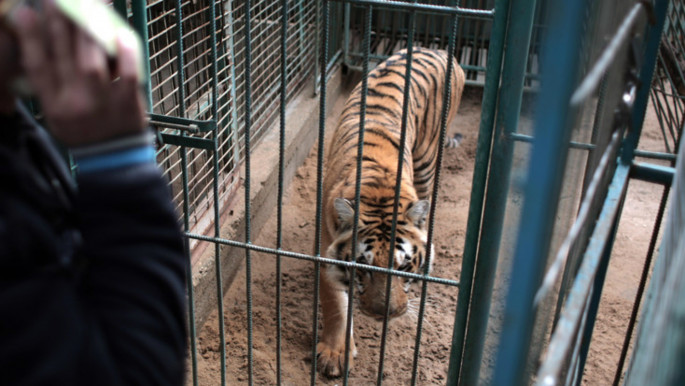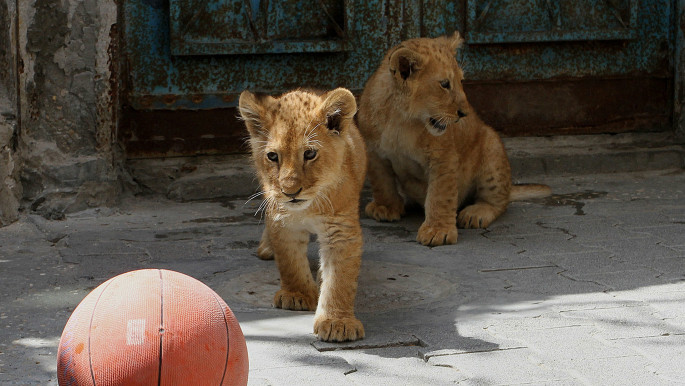Disease and hunger torment Gaza's zoo animals
The African tiger at the zoo in southern Gaza Strip was emaciated, its belly shrunken and its striped coat hanging loose. It strode nervously up and down its cage.
"I swear to God the tiger has not eaten for four or five days," said Mohammed Ouida, the owner of South Jungle Zoo. "It needs 100 shekels (about $20) of food a day."
Once bustling with families bringing their children to see lions, monkeys, crocodiles and ostriches, the zoo is mostly empty now, and Ouida can't generate enough cash to feed his animals.
The same story is playing out across Gaza's six makeshift zoos.
Years of conflict, cold winters, longstanding negligence and outbreaks of disease have killed many animals in captivity.
 |
Years of conflict, cold winters, longstanding negligence and outbreaks of disease have killed many animals in captivity. |  |
Even in better times, there has often been little awareness of animal welfare in Gaza.
In 2013, for instance, two lion cubs died shortly after birth because zoo workers in northern Gaza did not know how to care for them.
In another renowned scene captured on film, Gazans used a crane to lift a camel over the border fence from Egypt into Gaza as the animal twitched in the air in agony.
 |
|
| Mohammed Ouida says that half of the remaining animals in his zoo are ill [AP] |
South Jungle has even turned to taxidermy to keep its deceased animals on exhibit.
Conditions in Gaza, home to 1.8 million people, have steadily deteriorated.
The loss of one of Gaza's few allies, former Egyptian President Mohammed Morsi, who was ousted by the military in 2013 after protests against his rule, and a 2014 war with Israel have hit the territory especially hard.
Unemployment is estimated by World Bank to stand at 43 percent, and Gazans suffer shortages of many goods, including electricity and cooking gas.
Over the past two years, Egypt has also shut its borders with Gaza, preventing Gazans from leaving the territory, and blocked smuggling tunnels.
The closure has not only stopped new animals from arriving, but also deprived Hamas of major smuggling tax revenues.
Cash-strapped Hamas has struggled to pay the salaries of its 40,000 employees.
"People have a hard time finding food, much less the animals," lamented Ouida, noting that half of the remaining 20 or so animals and birds in his zoo are ill because he also can't afford a veterinarian. Vets used to check his animals every two months.
 |
People have a hard time finding food, much less the animals |  |
Since the zoo opened in 2007, Ouida and his brothers have invested hundreds of thousands of dollars into their business.
They once employed 30 workers, and ran a cafeteria serving families and school trippers.
These days, Ouida works at a gravel quarry and his two brothers drive a taxi. Only two of them still show up at South Jungle.
The zoo's problems began during a 51-day war between Israel and Hamas in 2014.
The zoo was not directly hit, but neither Ouida nor his brothers could reach the site to feed the animals. The African tiger's mate starved to death.
Of the six ostriches, only one is still alive. The lions and the only llama died in December. There are no more crocodiles. The dead animals are primitively stuffed and stacked in a corner of the zoo.
 |
|
| Gaza Strip's zoos were once vibrant with families visiting [Getty] |
Most of Gaza's zoos are private business ventures, set up by owners who lack experience in caring for animals in captivity.
"Basically, it's improvisation by some citizens," said Zakaria al-Kafarna, veterinary official at the Hamas Agriculture Ministry, which only provides immunizations for livestock, not wild animals.
The effect of conflict and years of negligence is also evident at al-Bisan Zoo, built by Hamas in northern Gaza.
It was badly damaged during the 2014 war, when more than 80 animals and birds died.
A wildcat, two monkeys and a falcon fell sick and died in December.
The animals looked hungry and neglected, and were shivering from cold during a recent visit.
The zoo opened in 2007 as part of a Hamas built complex that also had swimming pools, soccer pitches and gardens.
The complex was destroyed in fighting with Israel.
No one visits anymore, and Hamas provides little money to care for the animals.
"Nobody is paying attention (to the zoo) because of the blockade and the situation. They don't take care of the animals at all," said Mohammed Abu Safia, of the zoo's administration.
 |
Nobody is paying attention to the zoo because of the blockade and the situation. They don't take care of the animals at all |  |
In 2014, an animal welfare organisation evacuated three scrawny lions from Al-Bisan to Jordan.
Last summer, the same charity, Four Paws International, helped send two lion cubs to a safe sanctuary in Jordan after Ouida, the South Jungle Zoo owner, sold them.
Ouida says he would be "thankful" for any outside help. "I'm waiting for someone to buy the zoo or for the animals to die," he said.







